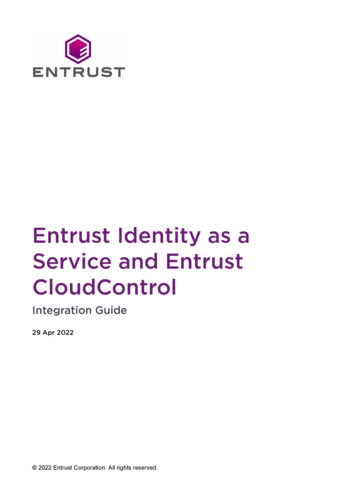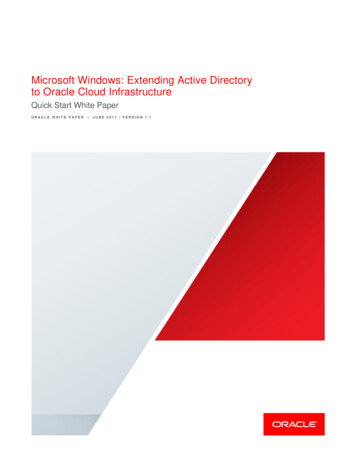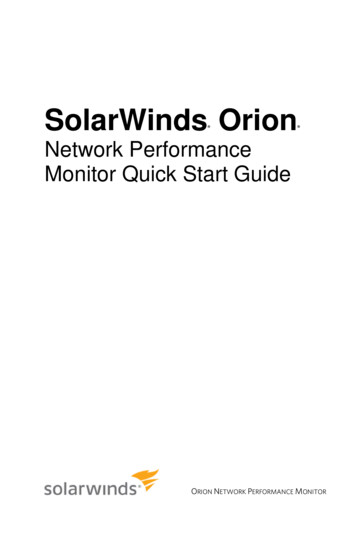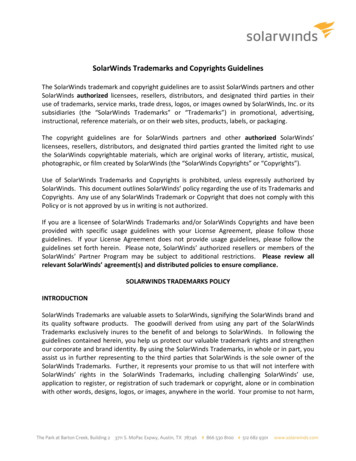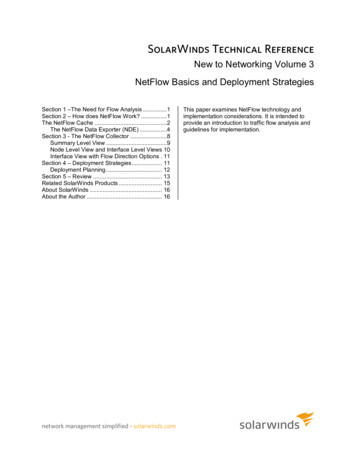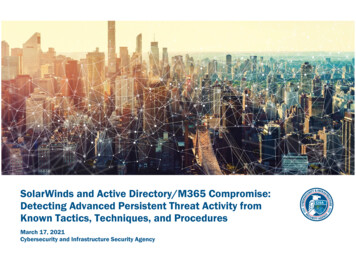
Transcription
SolarWinds and Active Directory/M365 Compromise:Detecting Advanced Persistent Threat Activity fromKnown Tactics, Techniques, and ProceduresMarch 17, 2021Cybersecurity and Infrastructure Security Agency
TLP:WHITEUpdated April 15, 2021: The U.S. Government attributes this activity to the Russian Foreign Intelligence Service (SVR).Additional information may be found in a statement from the White House. For more information on SolarWinds-related activity,go to ed-networks and DUCTIONThe advanced persistent threat (APT) actor associated with the SolarWinds Orion supply chain compromise moved laterally tomultiple systems—including Microsoft cloud environments—and established difficult-to-detect persistence mechanisms. TheCybersecurity and Infrastructure Security Agency (CISA) is providing this resource to assist network defenders in scoping theintrusion by detecting artifacts from known tactics, techniques, and procedures (TTPs) associated with this activity. Although thisresource is tailored to organizations that were compromised via the SolarWinds Orion supply chain compromise, CISA is awareof other initial access vectors and organizations should not assume they are not compromised by this APT actor solely becausethey have never used affected versions of SolarWinds Orion. Additionally, this resource addresses follow-on activity observed inthe Microsoft Azure Active Directory (AD), Office 365 (O365), and M365 environments. Organizations should confirm they have notobserved related TTPs described in this resource, and, if they detect related activity, refer to CISA Alert AA20-352A: AdvancedPersistent Threat Compromise of Government Agencies, Critical Infrastructure, and Private Sector Organizations and contactCISA for further assistance.For additional technical information on the SolarWinds Orion supply chain and Active Directory/M365 compromise, refer to ks. For information on CISA’s response to this activity, refer tocisa.gov/supply-chain-compromise.Threat Actor Tactics and TechniquesFigure 1 and table 1 identify threat actor tactics and techniques observed by incident responders using the MITRE AdversarialTactics, Techniques, and Common Knowledge (ATT&CK ) framework, Version 8. See the ATT&CK for Enterprise framework forall referenced threat actor tactics and techniques. Note: Neither figure 1 nor table 1 should be considered exhaustive—not alltechniques have been used in every incident, and some techniques may not have been identified.2CISA DEFEND TODAY, SECURE TOMORROWTLP:WHITE
TLP:WHITEFigure 1: MITRE ATT&CK Techniques Observed3CISA DEFEND TODAY, SECURE TOMORROWTLP:WHITE
TLP:WHITETable 1 identifies tactics and techniques observed by incident responders and provides associated detection recommendations.Table 1: Threat Actor Techniques and Associated Detection ArtifactsTacticTechniqueThreat Actor ActivityDetection RecommendationsCredentialAccess[TA0006]Forge WebCredentials:SAML Tokens[T1606.002]The threat actor created tokens usingMonitor for anomalous logins from on-premises and cloud environments thatcompromised Security Assertion Markup trust the token signing certificate. Search for logins to service providers usingSAML Single Sign On (SSO) that do not have corresponding events 4769,Language (SAML) signing certificates. 11200, and 1202. 2DefenseEvasion[TA0005]Use AlternateAuthenticationMaterial[T1550]The actor used forged SAML tokens toimpersonate existing users in theenvironment with full authentication. 3,4The users being leveraged are valid users, so the artifacts are behavioral.Look for user accounts, especially privileged and service accounts, behavingabnormally.Cyber attackers prefer to use compromised credentials, so identifyingaccounts that use multiple login pathways, geolocations, or virtual privatenetwork (VPN) services might lead to discovery of compromised credentials,malicious autonomous systems numbers (ASNs), and suspicious nternal IP management or scanning capability may show IP addressesswitching between default (WIN-*) hostnames and victim’s hostnames. 5ScheduledTask/Job:Scheduled Task[T1053.005]The threat actor used scheduler andschtasks to create new tasks on remotehosts as part of lateral movement. Thethreat actor also manipulated ScheduledTasks by updating an existing legitimatetask to execute their tools and thenreturned the Scheduled Task to itsoriginal configuration. 6,7Audit existing scheduled tasks in the environment and review against knownand expected scheduled tasks; MITRE ATT&CK recommends looking “forchanges to tasks and services that do not correlate with known software,patch cycles etc.” 8 Verify the tasks do what they are intended to do, as thisactor is known to alter existing legitimate tasks.MITRE ATT&CK also recommends monitoring “processes and command-linearguments for actions that could be taken to create tasks or services." 9 InWindows 10, monitor process execution from the svchost.exe. In older4CISA DEFEND TODAY, SECURE TOMORROWTLP:WHITE
TLP:WHITETacticPersistence[TA0003]TechniqueThreat Actor ActivityDetection Recommendationsversions of Windows, monitor the Windows Task Scheduler taskeng.exe. Ifyou do not observe Scheduled Tasks used for persistence, then the adversarymay have removed the task after it was no longer needed. 10The threat actor created a ScheduledScheduledTask to maintain SUNSPOT persistenceTask/Job:Scheduled Task when the host booted. 12[T1053.005]Monitor Windows Scheduled Tasks stored in%systemroot%\System32\Tasks. Look for changes related to ScheduledTasks that do not correlate with known software updates etc. k or Service[T1036.004]The threat actor named \EventCacheManagerin order to appear legitimate. n[T1047]The threat actor used WindowsManagement Instrumentation (WMI) forthe remote execution of files for lateralmovement. Monitor network traffic for WMI connections. WMI connections inenvironments that do not usually use WMI may be an indicator ofcompromise. Capture command-line arguments of wmic via processmonitoring and look for commands that are used for remote behavior. 17According to Microsoft, the following was used for lateral movement via WMI:wmic /node:[target] process call create “rundll32c:\windows\[folder]\[beacon].dll [export]”. 18Note: detecting WMI connections for execution requires detecting it at thetime it happens.Event Triggered The threat actor used WMI eventExecution:subscriptions for persistence. tion[T1546.003]5CISA DEFEND TODAY, SECURE TOMORROWTLP:WHITE
TLP:WHITETacticTechniqueThreat Actor ActivityDetection RecommendationsExfiltration[TA0010]Exfiltration over The threat actor used HTTP for commandand control (C2) and data exfiltration. 21C2 ChannelThe threat actor’s malware used HTTP[T1041]PUT or HTTP POST requests whencollected data was being exfiltrated totheir C2 server. 22Look for unusual outbound HTTP PUT or HTTP POST requests. If the payloadis bigger than 10000 bytes, the POST method is used. If the payload is smallerthan 10000 bytes, the PUT method is used. All HTTP POST and HTTP PUTrequests will have a JavaScript Object Notation (JSON) containing the keysuserId, sessionId, and steps. The steps field contains a list of objects withthe following keys: Timestamp, Index, EventType, EventName,DurationMs, Succeeded, and Message. The JSON key EventType ishardcoded to the value Orion, and the EventName is hardcoded toEventManager. teName orLocation[T1036.005]Investigate executables with parameters that do not match their knownbehavior. Profile expected behavior of binaries, especially code that runs withadmin permissions, to identify unusual behavior. Compare the hashes ofrunning versions of executables with the hashes of known legitimateexecutables. The following resources provide examples of uses of Rundll32seen.The threat actor renamed a version ofAdFind to sqlceip.exe or csrss.exein an attempt to appear as the StructuredQuery Language (SQL) Server TelemetryClient or Client Service Runtime Process,respectively. 24,25Signed Binary The threat actor used Rundll32 toProxy Execution: execute payloads. 26,27Rundll32[T1218.011]Discovery[TA0007]Remote System The threat actor used AdFind toDiscoveryenumerate remote systems. 28[T1018] Volexity: Dark Halo Leverages SolarWinds Compromise to BreachOrganizations Microsoft: Analyzing Solorigate, the compromised DLL file that starteda sophisticated cyberattack, and how Microsoft Defender helpsprotect customersLook for executables with the following parameters (they may be the AdFindutility renamed): [renamed-adfind].exe -h [internal domain]-sc u:[user] .\\[machine]\[file].[log txt]. 29Refer to Microsoft: Deep dive into the Solorigate second-stage activation:From SUNBURST to TEARDROP and Raindrop for other uses of thisexecutable. Note: this executable may be renamed to evade detection; referto MITRE T1036.005 for guidance on detecting renamed files.6CISA DEFEND TODAY, SECURE TOMORROWTLP:WHITE
TLP:WHITETacticTechniqueThreat Actor ActivityDetection iscovery[T1082]The threat actor used fsutil toLook for the following fsutil command: fsutil volume diskfree c:. 31determine if there was sufficientavailable free space before executingactions that might generate large files ondisk. 30DefenseEvasion[TA0005]IndicatorRemoval onHost:Timestomp[T1070.006]The threat actor modified timestamps ofbackdoors to match legitimate Windowsfiles. 32Use forensic techniques to detect files that have had their timestampsmodified. Detecting timestomping may be possible by using file modificationmonitoring that collects information on file handle opens and can comparetimestamp values. 33CredentialAccess[TA0006]OS CredentialDumping:DCSync[T1003.006]The actor leveraged privileged accountsto replicate directory service data withdomain controllers. 34,35,36MITRE ATT&CK recommends the following: “Monitor domain controller logs forreplication requests and other unscheduled activity possibly associated withDCSync. Also monitor for network protocols and other replication requestsfrom IPs not associated with known domain controllers.” 37DefenseEvasion[TA0005]IndicatorRemoval onHost: FileDeletion[T1070.004]Once remote access was achieved, thethreat actor frequently removed theirtools, including custom backdoors. 38Monitor command-line deletion functions and compare them with binaries orother files that the threat actor may have dropped and removed. Monitor forknown deletion and secure deletion tools that the actor may have introducedto the network. 39DefenseEvasion[TA0005]IndicatorRemoval onHost [T1070]The threat actor removed evidence ofemail export requests using RemoveMailboxExportRequest. The threatactor temporarily replaced legitimateutilities with their own, executed theirpayload, and then restored the originalfile. 40,41Enable command-line parameter monitoring, and look for:C:\Windows\system32\cmd.exe /C powershell.exe -PSConsoleFileexshell.psc1 -Command “Get-MailboxExportRequest -Mailboxuser@organization.here Remove-MailboxExportRequest Confirm: False”. 427CISA DEFEND TODAY, SECURE TOMORROWTLP:WHITE
TLP:WHITETacticTechniqueThreat Actor ActivityDetection scovery[T1069]The threat actor used the GetManagementRoleAssignmentPowerShell cmdlet to enumerateExchange management role assignmentsthrough an Exchange ManagementShell. 43Enable command-line parameter monitoring, and look for:C:\Windows\system32\cmd.exe /C powershell.exe -PSConsoleFileexshell.psc1 -Command “Get-ManagementRoleAssignment GetEffectiveUsers ,IsValid ConvertTo-Csv -NoTypeInformation % { -replace ‘ n’,’ ’} Out-File C:\temp\1.xml”. 44Discovery[TA0007]File andDirectoryDiscovery[T1083]The threat actor obtained informationabout the configured Exchange virtualdirectory using GetWebServicesVirtualDirectory. 45Enable command-line parameter monitoring, and look for:C:\Windows\system32\cmd.exe /C powershell.exe -PSConsoleFileexshell.psc1 -Command “Get-WebServicesVirtualDirectory Format-List”. 46Execution[TA0002]Command and The threat actor used cmd.exe toScriptingexecute commands on remoteInterpreter:machines. 47WindowsCommand Shell[T1059.003]Execution[TA0002]Command andScriptingInterpreter:PowerShell[T1059.001]The threat actor used PowerShell tocreate new tasks on remote machines,identify configuration settings, exfiltratedata, and to execute other commands. 49AccountDiscovery[T1087]The threat actor obtained a list of usersand their roles from an Exchange serverusing GetManagementRoleAssignment. 54,55Microsoft Windows cmd.exe was used to run powershell.exe, AdFind(often renamed to a number of other names), and other commands. 48 Useprocess tracking, event logging, and PowerShell monitoring functions toidentify use of these command-line tools.Review PowerShell cmdlets that involve adding or changing permissions orroles to existing accounts, applications, and service principals or that useOut-File filenames and unusual locations (such as C:\TEMP). 50Organizations should review these sources and determine if the changes theymake are expected and authorized.Look for PowerShell being used to create Scheduled Tasks on remotemachines with command parameters that look like this: scheduler New-Object -ComObject(“Schedule.Service”); scheduler.Connect( env:COMPUTERNAME); 8CISA DEFEND TODAY, SECURE TOMORROWTLP:WHITE
TLP:WHITETacticTechniqueDiscovery[TA0007]Domain ipulation:Exchange EmailDelegatePermissions[T1098.002]Threat Actor ActivityDetection RecommendationsThe threat actor used the GetAcceptedDomain PowerShell cmdletto enumerate accepted domains throughan Exchange Management Shell. Theyalso used AdFind to enumerate domainsand to discover trust between federateddomains. 56folder ProtectionPlatform”); task folder.GetTask(“EventCacheManager”); definition task.Definition; definition.Settings.ExecutionTimeLimit “PT0S”; folder.RegisterTaskDefinition( task.Name, definition,6,”System”, null,5);echo “Done”. 51Look for events related to Beacon commands jump psexec and jumppsexec psh—these commands will generate an EventID 7045 (ServiceThe threat actor added their own devices Installation) from System.evtx. The additional commands will generate anas allowed identifications (IDs) for active EventID 400 event log (PowerShell Engine Startup) from Windowssync using Set-CASMailbox, allowingPowerShell.evtx.their devices to obtain copies of victimSince this attacker is adept at PowerShell, CISA recommends enablingmailboxes. The actor also addedPowerShell logging and monitoring use of the tool. Look cmdlets in PowerShelladditional permissions (such aslogs, including the following: 52Mail.Read and Mail.ReadWrite) tocompromised application or service Get-ManagementRoleAssignmentprincipals. 57 Get-AcceptedDomain Get-CASMailbox Get-Mailbox Get-OrganizationConfig Get-OwaVirtualDirectory Get-Process Get-WebServicesVirtualDirectory New-MailboxExportRequest Remove-MailboxExportRequest Set-CASMailbox Export-pfxcertificate Export-Certificate Add-AdfsCertificate Get-AdfsCertificate Get-AdfsSslCertificate New-AdfsAzureMfaTenantCertificate SEt-AdfsCertificate9CISA DEFEND TODAY, SECURE TOMORROWTLP:WHITE
TLP:WHITETacticTechniqueThreat Actor ActivityDetection Recommendations SEt-AdfsSslCertificate Update-AdfsCertificate Set-mppreference Compress-Archive Invoke-Command Invoke-WMIMethodFor more information on PowerShell logging, refer to FireEye: Greater VisibilityThrough PowerShell Logging.Modification of mail delegation rules and changes to the behavior orfrequency of mail traffic being sent may be a sign that a compromisedaccount is being leveraged by threat actors. 53DefenseEvasion[TA0005]ObfuscatedFiles orInformation[T1027]The threat actor used encodedPowerShell commands. 58The attacker is known to use PowerShell's built-in ability to take Base64encoded parameters (the -EncodedCommand parameter). 59 There are manyways this can be called, so defenders should familiarize themselves with whatthis can look like in PowerShell logs using the following resources: Persistence[TA0003]AccountManipulation:Additional CloudCredentials[T1098.001]The threat actor added credentials toAzure service principals/applicationsafter gaining access to the Microsoft 365(M365) environment. 60,61Palo Alto Networks Unit 42: Pulling Back the Curtains on EncodedCommand PowerShell AttacksMicrosoft: Customer Guidance on Recent Nation State Cyber AttacksLook for behavioral artifacts, such as accounts behaving abnormally, andverify information such as IP and/or user agent strings are normal. Identify ifcredentials have been added to service principals/applications (such asSharePoint and Microsoft Teams) that previously did not have them. Check10CISA DEFEND TODAY, SECURE TOMORROWTLP:WHITE
lection:Remote EmailCollection[T1114.002]Threat Actor ActivityCollected emails from accounts ofspecific individuals, such as executivesand IT staff, using NewMailboxExportRequest followed byGet-MailboxExportRequest.The actor used Azure serviceprincipals/applications with addedcredentials to exfiltrate emails fromspecific users. 63Initial Access[TA0001]Supply ChainThe threat actor gained initial networkCompromise:access via a Trojanized update ofCompromiseSolarWinds Orion software. 64,65Software SupplyChain[T1195.002]Execution[TA0002]Command andScriptingInterpreter:WindowsCommand T1057]Detection Recommendationswith administrators to ensure applications are supposed to have credentials(and the type of credential) associated with them.Monitor for use of Application Programming Interfaces (APIs) that create orimport Secure Shell (SSH) keys, especially by unexpected users or accountssuch as root accounts. 62Refer to the SolarWinds Security Advisory for details on versions affected.Refer to CISA Alert: AA20-352A: Advanced Persistent Threat Compromise ofGovernment Agencies, Critical Infrastructure, and Private Sector Organizationsfor immediate mitigation recommendations.The threat actor “lived off the land” byReview the following Windows commands and investigate if each use wasusing native commands in Windows. The legitimate. (Note: this list of commands not exhaustive.) 68,69,70actor used multiple command-line cmd.exeutilities to enumerate running 7z.exe66,67processes. Powershell.exe schtasks certutil whoami rundll32.exe wmic auditpol sc net netsc fsutil11CISA DEFEND TODAY, SECURE TOMORROWTLP:WHITE
TLP:WHITETacticTechniqueThreat Actor ActivityDetection Recommendations PrivilegeEscalation[TA0004]Domain PolicyModification:Domain TrustModification[T1484.002]regnslookupMonitor for Event ID 307, which can be correlated to relevant Event ID 510with the same Instance ID for change details. 72The threat actor changed domainfederation trust settings using AzureActive Directory (AD) administrativepermissions to configure the domain toaccept authorization tokens signed bytheir own SAML signing certificate. 71Monitor for PowerShell commands such as: 73 Update-MSOLFederatedDomain –DomainName: "FederatedDomain Name"Update-MSOLFederatedDomain –DomainName: "FederatedDomain Name" –supportmultipledomainLook for behavioral artifacts in UnifiedAuditLogs (PowerShell - ExchangeOnline) to help detect potential SAML abuse.DefenseEvasion[TA0005]Use AlternateAuthenticationMaterial[T1550]The threat actor used SAML tokens toimpersonate existing cloud users in thecloud environment with fullauthentication and was able to bypassmulti-factor authentication (MFA). 74,75CredentialAccess[TA0006]Forge WebCredentials:SAML Tokens[T1606.002]The threat actor created tokens usingcompromised SAML signingcertificates. 76LateralMovement[TA0008]Use AlternateAuthenticationMaterial[T1550]The threat actor used forged SAMLtokens that allowed them to impersonateusers and bypass MFA, enabling them toaccess enterprise cloud applications andservices. 77Note: prior to October 31, 2020 the UnifiedAuditLogs (PowerShell Exchange Online) showed the UserAuthenticationMethod of 16457 tohelp detect potential SAML abuse ( in conjunction with other indicators suchas user behavior, whether the user is part of the domain (guest accountsproduce 16457 somewhat frequently depending on how the environment isset up). However, since 16457 was removed, the artifacts will be behavioral.12CISA DEFEND TODAY, SECURE TOMORROWTLP:WHITE
TLP:WHITETacticTechniqueThreat Actor ActivityDefenseEvasion[TA0005]Deobfuscate/D The threat actor used 7-Zip to decodeecode Files or their RAINDROP malware. 78Information[T1140]Collection[TA0009]ArchiveThe threat actor used 7-Zip to archiveCollected Data: collected data of interest for removalArchive viafrom the environment. e threat actor used AUDITPOL toDefenses:prevent the collection of audit logs. 80DisableWindows rDefenses:Disable orModify SystemFirewall[T1562.004]Detection RecommendationsLook for the use of compression utilities such as run from or in unusuallocations such as C:\Windows/system32 and others (these utilities mayhave previously existed on the system or have been installed by the threatactor). 7z.exe creates compressed files (ending in .7z) that may then besecurely deleted by the threat actor.Look for the built-in command auditpol used in the following ways 81 auditpol /GET /category:"Detailed Tracking"auditpol /set /category:"Detailed Tracking"/success:disable /failure:disable[execution ofseveral commands and actions]auditpol /set /category:"Detailed Tracking"/success:enable /failure:enableThe threat actor used netsh to configure Refer to the following resources for guidance on detecting this.firewall rules that limited certain User CISA Activity Alert: AA21-008A Detecting Post-Compromise ThreatDatagram Protocol (UDP) outboundActivity in Microsoft Cloud Environments82,83packets. Microsoft: Deep dive into the Solorigate second-stage activation:From SUNBURST to TEARDROP and Raindrop13CISA DEFEND TODAY, SECURE TOMORROWTLP:WHITE
TLP:WHITETacticTechniqueThreat Actor ActivityDetection RecommendationsImpairDefenses:Disable orModify Tools[T1562.001]The threat actor disabled servicesassociated with security monitoringproducts by using the service controlmanager on a remote system. 84Look for the built-in command sc used the following ways:DefenseEvasion[TA0005]Masquerading[T1036]The threat actor matched hostnames ofits command and control (C2)infrastructure with legitimate hostnamesin the victim environment. The actorprimarily used IP addresses originatingfrom the same country as the victim fortheir VPN infrastructure. 85Geolocate IP addresses and look for “impossible travel.” 86 Impossible traveloccurs when a user logs in from multiple IP addresses that are a significantgeographic distance apart (i.e., a person could not realistically travel betweenthe geographic locations of the two IP addresses during the time periodbetween the logins). Note: implementing this detection opportunity can resultin false positives if legitimate users apply VPN solutions before connectinginto networks.DefenseEvasion[TA0005]Subvert TrustControls: CodeSigning[T1553.002]The threat actor ensured Orion codeN/Acontaining SUNBURST was signed bySolarWinds code signing certificates byinjecting the malware into the SolarWindsOrion software lifecycle. 87DefenseEvasion[TA0005]Use AlternateThe threat actor used a forged duo-sidAuthentication cookie to bypass MFA set on an emailMaterial: Web account. 88Session Cookie[T1550.004]MITRE ATT&CK recommends the following: “Monitor for anomalous access ofwebsites and cloud-based applications by the same user in different locationsor by different systems that do not match expected configurations.” 89CredentialAccess[TA0006]Forge WebCredentials:Web Cookies[T1606.001]MITRE ATT&CK recommends the following: “Monitor for anomalousauthentication activity, such as logons or other user session activityassociated with unknown accounts. Monitor for unexpected and abnormalaccess to resources, including access of websites and cloud-basedapplications by the same user in different locations or by different systemsthat do not match expected configurations.” 91DefenseEvasion[TA0005] The threat actor bypassed the MFA set onOutlook on the Web (OWA) accounts bygenerating a cookie value from apreviously stolen secret key. 9014On the source machine: sc \\[dest machine] stop [servicename][perform lateral move Source- Dest]On the destination machine: sc \\[source machine] start[service name]CISA DEFEND TODAY, SECURE TOMORROWTLP:WHITE
TLP:WHITETacticTechniqueThreat Actor ActivityDetection RecommendationsCredentialAccess[TA0006]Steal or ForgeKerberosTickets:Kerberoasting[T1558.003]The threat actor obtained Ticket GrantingService (TGS) tickets for Active DirectoryService Principal Names for offlinecracking. 92Log Kerberos TGS service ticket requests by enabling Audit Kerberos ServiceTicket Operations to log. Investigate irregular activity (e.g., accounts makingnumerous requests, accounts making requests within a short period,accounts triggering Event ID 4769). 93 For more information on detectingkerberoasting, refer to TrustedSec: The Art of Detecting Kerberoast Attacks.CredentialAccess[TA0006]CredentialsThe threat actor used compromisedfrom Password account credentials to attempt access to Monitor processes, system calls, and file read events and look for activityStores [T1555] Group Managed Service Account (gMSA) related to password searches (e.g., keyword searches for password, pwd,passwords. 94login, secure, credentials) in the process memory for credentials. Monitor fileread events around known password storage applications. vate Keys[T1552.004]The threat actor obtained the privateencryption key from an Active DirectoryFederation Services (ADFS) container todecrypt corresponding SAML signingcertificates. 96MITRE ATT&CK recommends the following: “Monitor access to files anddirectories related to cryptographic keys and certificates patterns that mayindicate collection and exfiltration activity. Collect authentication logs and lookfor potentially abnormal activity that may indicate improper use of keys orcertificates for remote authentication.” oteManagement[T1021.006]The threat actor used WinRM viaPowerShell to execute command andpayloads on remote hosts. 98Monitor WinRM use by tracking service execution. Abnormal WinRM activity(e.g., if WinRM is normally not used or is normally disabled) observed, this mayindicate suspicious behavior. Monitor WinRM processes, actions, and invokedscript to correlate the activity with other related events. 99Collection[TA0009]Data Staged:Remote DataStaging[T1074.002]The threat actor staged data and files in Monitor publicly writeable directories and central locations as well as recyclepassword-protected archives on a victim's bins, temp folders, etc., that are commonly used for staging. Look forOWA server. 100encrypted or compressed data, which may be a sign of staging. Indicators ofdata being staged include processes that appear to be reading files fromdisparate locations and writing them to the same directory or file, especially ifthey are suspected of performing encryption or compression (such as 7zip,RAR, ZIP, or zlib) on the files. 101Monitor processes and command-line arguments and look for actions tocollect and combine files. Data may be acquired and staged through remote15CISA DEFEND TODAY, SECURE TOMORROWTLP:WHITE
TLP:WHITETacticTechniqueThreat Actor ActivityDetection Recommendationsaccess tools with built-in features that interact directly with the Windows APIor through Windows system management tools such as WMI andPowerShell. 102Command and Ingress Transfer The threat actor downloaded additionalControlTool [T1105]tools, such as TEARDROP malware and[TA0011]Cobalt Strike, to the compromised hostfollowing the initial compromise. 103,104Refer to the following Malware Analysis Reports for IOCs associated with theAPT actor’s malware. If any IOCs are detected, remove the implant.Command and lgorithms[T1568.002]The threat actor used dynamic DomainName System (DNS) resolution toconstruct and resolve to randomlygenerated subdomains for C2. 105This is challenging to detect. Look for domain generation algorithms (DGAs) bylooking for domains in DNS logging that exhibit a high degree of entropy. Formore information, refer to:Command and Proxy: InternalControlProxy[TA0011][T1090.001]The threat actor configured at least one Refer to the following Malware Analysis Reports for IOCs associated with theinstance of Cobalt Strike to use a network APT actor’s malware. If any IOCs are detected, remove the implant.pipe over Server Message Block MAR-10318845-1.v1 - SUNBURST(SMB). 106 MAR-10320115-1.v1 - TEARDROP MAR-10318845-1.v1 - SUNBURSTMAR-10320115-1.v1 - TEARDROPRed Canary: Using Entropy in Threat Hunting: a Mathematical Searchfor the UnknownActive Countermeasures: Real Intelligence Threat AnalyticsData Sources16CISA DEFEND TODAY, SECURE TOMORROWTLP:WHITE
TLP:WHITEThe below recommendations serves as a starting point for network defende
Audit existing scheduled tasks in the environment and review against known and expected scheduled tasks; MITRE ATT&CK recommends looking "for changes to tasks and services that do not correlate with known software, patch cycles etc." 8. Verify the tasks do what they are intended to do, as this actor is known to alter existing legitimate tasks.
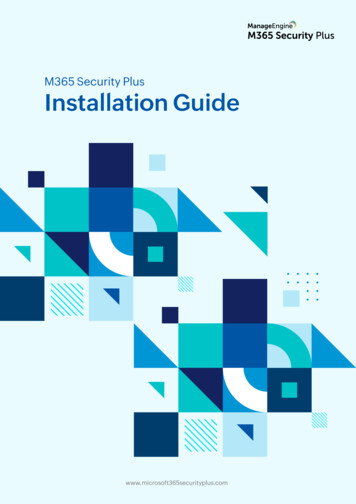

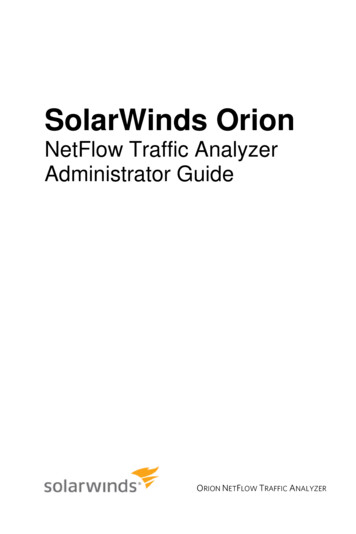
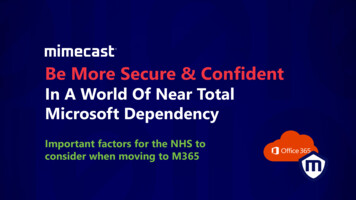
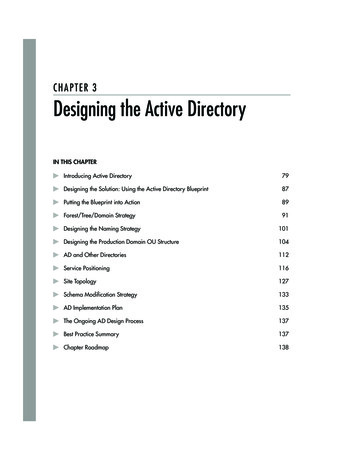
![[MS-ADFSOD]: Active Directory Federation Services (AD FS .](/img/1/5bms-adfsod-5d.jpg)
